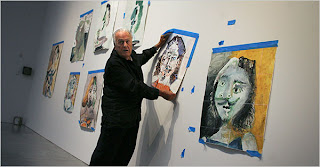
Thursday, March 26, 2009
Tuesday, March 24, 2009
Creative Non-Fiction

An example of weaving art history, personal narrative, travel writing, and meditative prose together comes in Julia Blackburn's Old Man Goya. An excerpt from the first chapter demonstrates how Blackburn works to weave together these several voices and genres. Her own history with the artist, her mother's illness, a journey to Spain, and Goya's unfolding biography (especially his deafness) become wed through close examinations of Goya's paintings. For good (I think) or for ill (some other readers suggest) this allows Blackburn to imaginatively enter Goya's world, to speculate on his visions of the landscapes she is now exploring (and to see them as so strongly influenced by her experience of Goya, that perhaps she cannot see them on her own). Here is Blackburn on watching a bullfight as Goya might have:
He looks up at the tiered rows of faces, rippling and swaying together. He sees that this crowd has the same questing, hungry energy as a crowd of pilgrims approaching a shrine, as soldiers going to battle, as men gathered together to witness an execution. He sees the fickleness of the crowd, calling for blood and revenge in one moment and begging for mercy and salvation the next.
Another example of ekphrastic fiction

Edward Hirsch's Transforming Vision (1994) collects prose and poetry responding to works in the Art Institute of Chicago. While of course heavy on the poetry, one of the excerpts from fiction includes this passage from Saul Bellow's Humboldt's Gift, in which Bellow describes his character, in part, through an encounter with a Monet Painting Sandivka, Norway:
He was waiting between the lions in front of the Institute, exactly as expected in the cloak and blue velvet suit and boots with canvas sides. The only change was in his hair which he was now wearing in the Directoire style, the points coming down over his forehead. Because of the cold his face was deep red. He had a long mulberry-colored mouth, and impressive stature, and warts, and the distorted nose and leopard eyes. Our meetings were always happy and we hugged each other. "Old boy, how are you? One of your good Chicago days. I've missed the cold air in California. Terrific! Isn't it. Well, we may as well start right with a few of those marvelous Monet's." We left attached case, umbrella, sturgeon, rolls, and marmalade in the checkroom. I paid two dollars for admission and we mounted to the Impressionist collection.
There was one Norwegian winter landscape by Monet that we always went to see straightaway: a house, a bridge, and the snow falling. Through the covering snow came the pink of the house, and the frost was delicious. The whole weight of snow, of winter, was lifted effortlessly by the astonishing strength of the light. Looking at this pure snowy dusky light, Thaxter clamped his pincenez on the powerful twisted bridge of his nose with a gleam of glass and silver and his color deepened. He knew what he was doing. With this painting his visit began on the right tone.
Willa Cather makes similar uses of art in her novels, a pattern detailed nicely here by Kathleen Nichols. One of my favorite bits from Cather comes, of course, in Song of the Lark, named after the iconic Art Institute owned painting by Jules Breton. Here is Thea's reverie about that work:

But in that same room there was a picture--oh, that was the thing she ran upstairs so fast to see! That was her picture. She imagined that nobody cared for it but herself, and that it waited for her. That was a picture indeed. She liked even the name of it, 'The Song of the Lark.' The flat country, the early morning light, the wet fields, the look in the girl's heavy face--well, they were all hers, anyhow, whatever was there. She told herself that that picture was 'right.' Just what she meant by this, it would take a clever person to explain. But to her the word covered the almost boundless satisfaction she felt when she looked at the picture.
Labels:
Art Institute,
Breton,
Cather,
edward hirsch,
ekprastic fiction,
Monet,
saul bellow
Subscribe to:
Posts (Atom)
